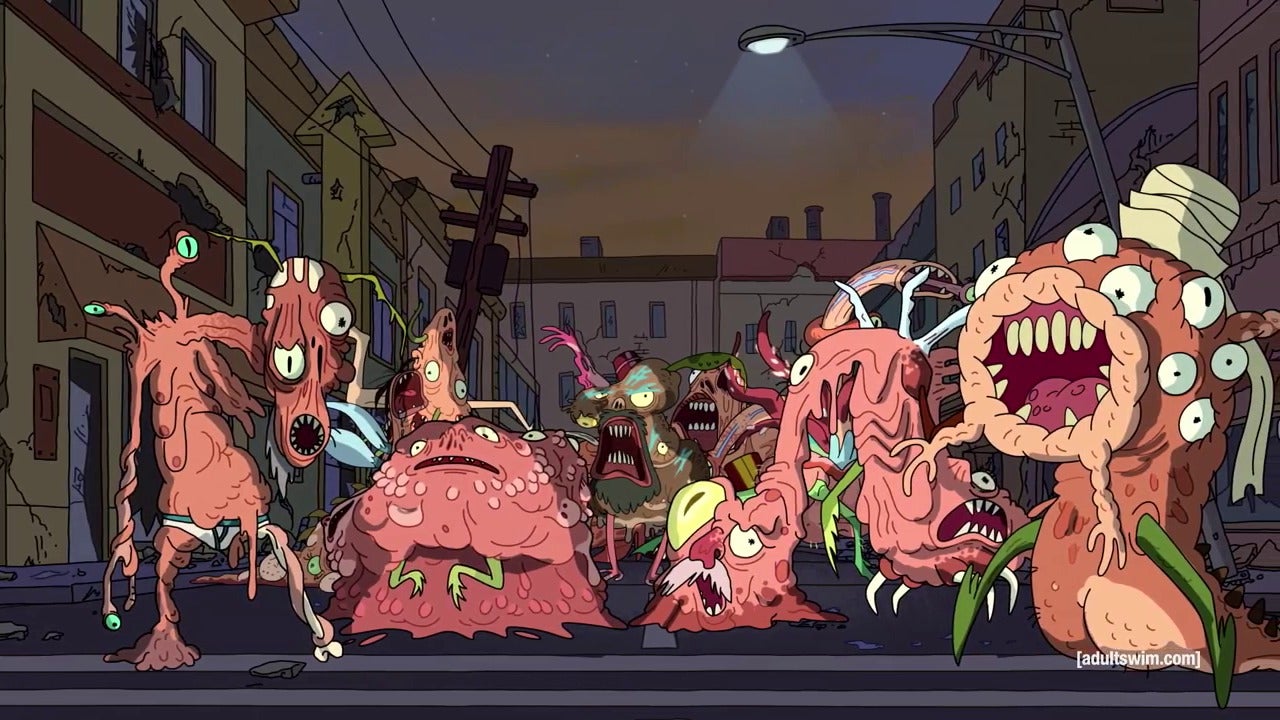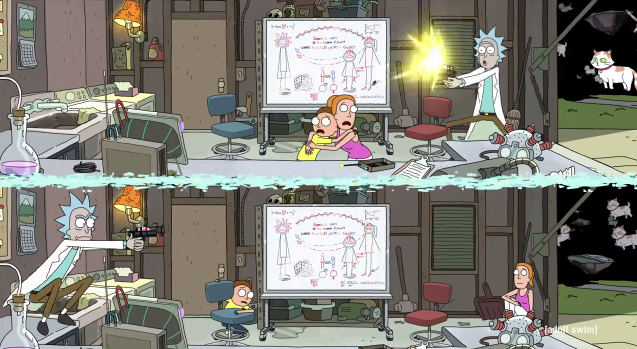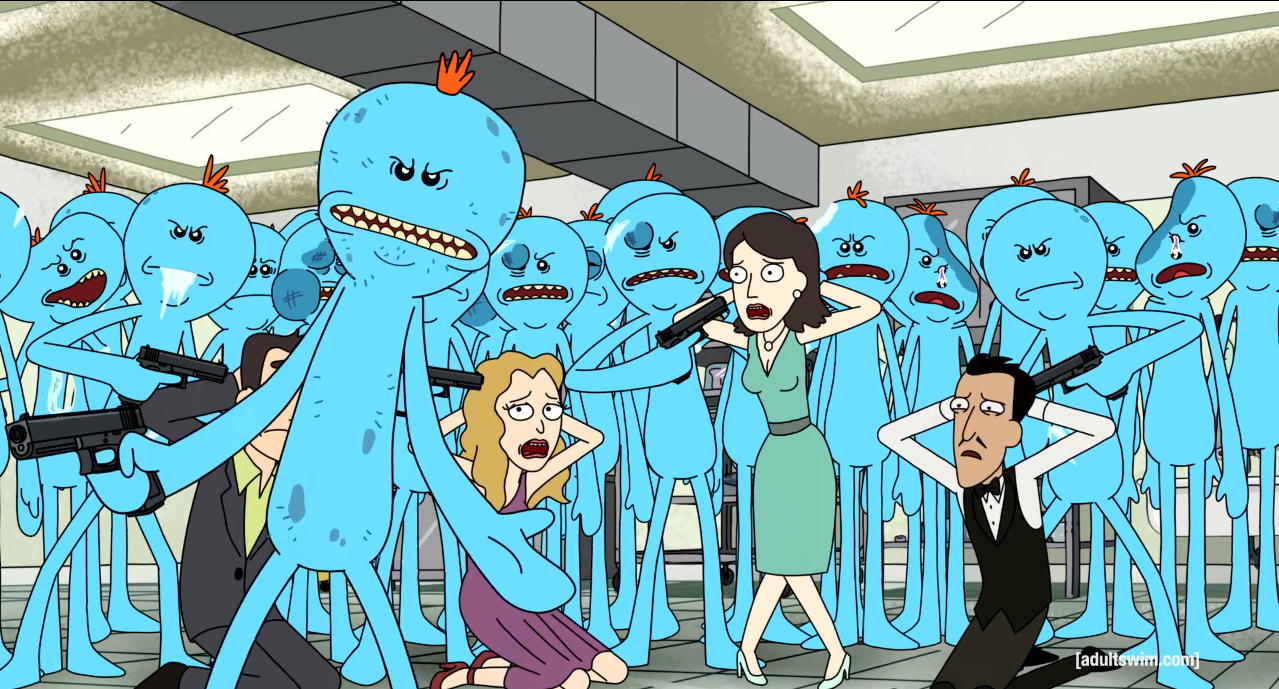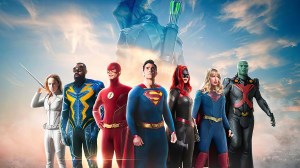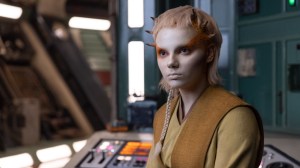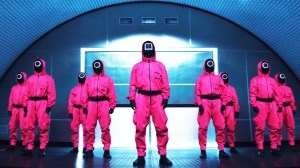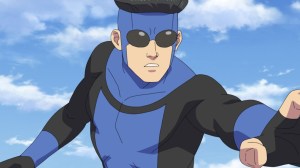With Rick & Morty recently returning for its second season, I have found myself once again recommending it to almost everyone I know. I try to target my media proselytization based on individual tastes and interests, but Rick & Morty is the rare example of a TV show that I think just about any of my friends and family could get something from. There’s something special about Dan Harmon and Justin Roiland’s series, featuring the sci-fi exploits of drunken grandpa Rick, bumbling grandson Morty, and the rest of their family.
Videos by ComicBook.com
I’ve been questioning why, exactly, it works so well. The quality of Rick & Morty is apparent, but the chemistry behind that isn’t quite as apparent. It’s funny, moving, and thought-inducing, but those are all effects, not causes. After pondering the first couple of new episodes, I think I have some ideas about why it’s such a success.
Characters, Not Caricatures
If you read my essays with any regularity, you’ll know that one of my constant refrains is the importance of character. Whether you’re talking story, conflict, or meaning, all of these things are bound to seem more authentic and have a greater effect when they are character-driven. While Rick & Morty features ludicrous situations and exaggerated lives, the characters at its core are consistent, understandable, and the source of all the action. They aren’t the broad, joke-producing caricatures of Family Guy, but recognizable people.
It’s easy to define any of the five family members outside of obvious traits and superficial connections. Just take a look at Beth (rather than Rick or Morty who get the most screentime). She’s driven by a constant need to prove herself, derived from an absentee, genius father. This results in both strengths and weaknesses, like an incredible work ethic and a grudge-inducing sense of pride. This plays into both her roles as a mother and career as a horse surgeon. Her maddening drive to save an injured deer in “A Rickle in Time” at the start of season two is based on a constant need to prove her own value. It’s silly, but it also makes perfect sense to anyone who got to know Beth in the first season. She isn’t saving a deer because the show requires a B-plot, but because it is her only possible response to the unfolding events.
Her relationships and interactions with each cast member is defined by her character as well. In the season one episode “Rixty Minutes,” Beth and her husband Jerry are shown an alternate reality where they lived their dreams of being a successful doctor (for people) and Hollywood star. It tears at the seams in their already shaky marriage, and reveals how they might respond to an entirely different life. Their stress and responses, both in the main timeline and alternate reality, all feel true to the previous eight episodes. It is only a story because of the characters involved, not the high-level premise. Rick & Morty only works as well as it does because the five people at its center are actual people with fully-realized relationships.
Commitment to Craziness
Unlike a lot of other cartoons, Rick & Morty doesn’t hit the reset button between episodes. Like any television show, character growth can take time, but it is definitely there. Most fans realized just how far Rick & Morty would go in the season one episode “Rick Potion #9”. At the end of the episode, Rick and Morty are the only survivors of a Cronenberg-esque apocalypse, and move to an Earth where they had recently died assuming new lives. While this ending allowed the show to maintain the superficial elements of its status quo, it had a dramatic effect on Morty. Forced to confront his mortality and the consequences of his own actions, Morty borders on a mental breakdown and grows considerably as a result. When people die or are changed, they stay that way in Rick & Morty.
This continuity also builds stakes and tension between episodes. Beth and Jerry’s mediocre marriage is a genuine concern for fans, because it’s always possible that it might not last. Their problems aren’t just a punchline, but a mounting source of concern. It’s easy to conceive of a future episode of Rick & Morty in which they split up, and that dramatically changing the status quo of the show. The second season two episode “Mortynight Run” even acknowledges this possibility. When Jerry is left at an inter-dimensional daycare, he runs into Paul Fleischman, who tells Jerry that in some realities Beth leaves him to remarry. This commitment and acknowledgement to change and growth makes for stories that feel important. Rick & Morty isn’t just arriving to deliver jokes and action once every week, but to keep building a narrative.
Creativity Over Constructs
Events like turning everyone on Earth into a Cronenberg-ian monster, or abandoning Jerry at an enormous daycare, show just how willing Harmon and Roiland are to pursue any idea in Rick & Morty. Given the pilot episode and basic premise for Rick and Morty, it would have been easy for the show to follow a time-tested pattern week in and week out. Rick and Morty would go on an adventure and leave the rest of the family to pursue a B-story. But even in the first season, the show drifted from this pattern regularly. Summer goes on an adventure with Rick in Morty’s stead in both “Raising Gazorpazorp” and “Something Ricked This Way Comes”. That has continued to become more prominent in the second season. The first episode “A Rickle in Time” places Rick, Morty, and Summer together at the story’s center, and “Mortynight Run” begins with Jerry joining them in the back of the spaceship with no explanation required.
This goes far beyond character pairings and A- and B-plots, though. Harmon’s experimentation with form in Community is regularly evidenced in Rick & Morty as well. Just take a look at “A Rickle in Time”. The episode centers on alternate timeline splitting, shown by static breaks in the television screen as each new break is shown in tandem. Not only does the episode manage to coherently show up to 64 unique timelines simultaneously, but it does so in a way that informs both character and meaning. Humor, action, and meaning can all be found in an episode that continues to add new “screens”, in a truly unique presentation. Ideas always come first in Rick & Morty, and Harmon and Roiland are more than willing to experiment and pursue even the wildest ones.
The Perfect Madness of Rick & Morty
These are just a few of the key elements that make Rick & Morty one of the best shows on television. There is so much that appears to be contradictory or unconnected, but it works. Rick & Morty is filled with big, sci-fi concepts, but it is entirely driven by characters. It maintains its own continuity, but makes each episode work on its own. It fits comfortably into a half-hour time slot, but explores whatever ideas and concepts it pleases. It’s all part of a bizarre chemistry that makes the whole transcend the individual parts.
And as good as Rick & Morty is right now, it still has a long way to go. “Auto Erotic Assimilation”, this week’s episode, manages to snag the title of “best episode yet” once again.




